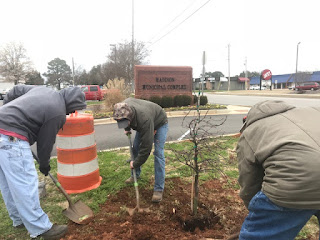Madison Beautification and Tree Board hosts Arbor Week with
Madison City School Poster Contest, Workshop and Tree Planting
MADISON CITY SCHOOL POSTER CONTEST
Vice President of Tree Board, Marsha Harris, kicked off Arbor week with Poster Contest with Madison City Schools. Each school submits posters from 5th graders to be judged across the State. Winners were selected from each school were awarded by Major Finley and the Madison Beatification and Tree Board
ARBOR DAY WORKSHOP
Madison City Hall Council Chamber
Wednesday, February 28th, 5:30pm
"Crepe Myrtle Proper Care and Trimming"
Lecturer: Reginald L. Randolph, Certified Arborist,
Owner/Operator of Professional Vegetation Management
Crape Myrtles are an iconic plant in the Southeastern United
States that can serve as hedging plants, as framing for front door entries, and
as the primary focal points of gardens.
The tree like shrub has undergone 200 years of cultivation to become
what it is today. The hundreds of varieties span from 3 foot tall dwarf plants to
20 foot tall canopy tree like structures, and their colors range from Spring to
Fall with their clusters of flowers and changing foliage. The many benefits of
the Crape Myrtle cultivars include disease resistance and cold tolerance that
make it an ideal plant to grow in the North Alabama area. Size is important to
consider when selecting Crape Myrtles. If you find a variety that can grow to
15-20 feet, trying to prune to 6 feet tall isn’t going to work. Find the right
size for the right place in your landscape, it will save you money and time.
Crape Myrtles are a hardy plant that need pruning. By
properly trimming these plants, you are providing more air flow, more sun
light, less chance of disease, and better bloom development. Ideal pruning of
Crape Myrtles should enhance the beauty, improve the health, and preserve the
natural shape of the plant. By adhering to the following steps, you can have a
better Crape Myrtle in your landscape:
- Pruning should take place during winter when all the leaves have dropped
- Starting from the base of the plant, remove any suckers (these compete with leader branches)
- Cut side branches and any branches that are rubbing against other branches
- Cut branches from the middle of the canopy to allow more airflow and sunlight to move through the plant
- Finally, finish by shaping the plant in a pleasing manner
Members of the audience solicited advice on how to come back from 'crape murder'. Randolph continued his lecture with suggestions to possibly improve and save the integrity of the shrub.
If you inherited a ‘Crape Murder’, you have two options to
correct the issue and possibly save the plant. The first and best option is to
cut the plant down to 1-2 inches above the ground and allow suckers to develop.
You will then choose a few of those suckers to continue as new leaders. Afterwards,
you will need to continue cutting back any new suckers. Recovery can take up to
3 to 5 years. Keeping no more than 4-6 leaders is best. Another option is to
cut out all knobs that have formed at the end of the leaders and thin out to a
few leaders. Removing the knobs can help establish healthier growth.
Randolph finished the presentation with recommendations of some of his favorite Crepe Myrtles. If you’re considering purchasing a Crape Myrtle for your
landscape, here are a few cultivars worth mentioning:
- Muscagee – disease resistant, light lavender blooms, 25 feet
- Tonto – mildew resistant, dark fuchsia-red blooms, 8-15 feet
- Plum Magic – semi dwarf, hot pink
- Crimson Red Black Diamond – new striking black foliage, red blooms, 10-12 feet
- Natchez – powdery mildew resistant, stark white blooms, 3-5 foot growth per year
- Tonto Hardy – disease resistant, red-pink blooms, 8-10 feet (ideal size for small gardens or containers)
TREE PLANING
Madison Beautification and Tree Board, Public Works, and Major Finley finished up Arbor week by planting new trees at Madison City Municipal Building. Two flowering Cherries and one replacement Japanese Maple were installed at three different locations on the property. The Board looks forward to continuing working to be a Tree City USA community.
 |
| Madison City recognized as a Tree City USA since 2001 {pictured: Liz Smith, Paul Finley, Reggie Randolph, Levoneia Ayers, Gerald Clark, Amber Braman, and Public Works} |


No comments:
Post a Comment